Effective Strategies for Eliminating Springtail Bugs
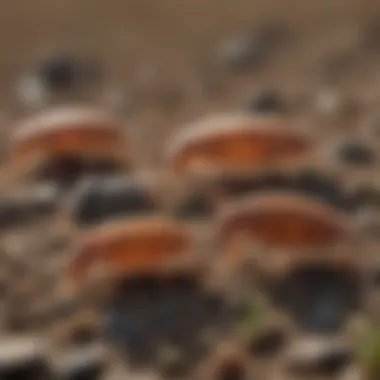
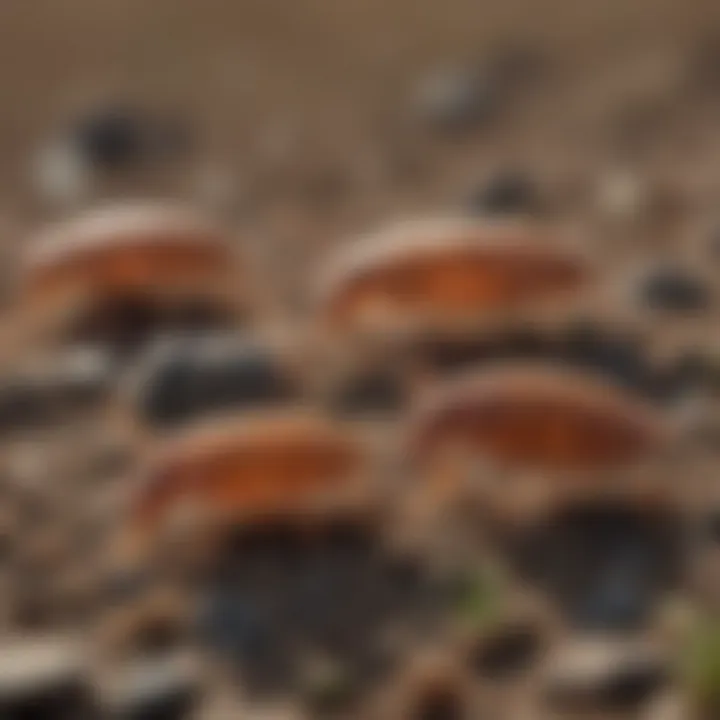
Intro
Springtail bugs are tiny pests that often go unnoticed until they become a significant problem. Their prevalence has increased in many homes, particularly due to environmental factors that favor their reproduction. Understanding how to identify, prevent, and treat springtail infestations is essential for homeowners seeking to maintain a comfortable living space. This article delves into effective strategies for eliminating these intrusive bugs, presenting a guide that is both practical and informative.
Pest Identification
Detailed Descriptions of Common Pests
Springtails are small, usually less than 1/16 of an inch long, and commonly found in damp areas. They have soft bodies and are often gray, brown, or pale in color. Their most distinctive feature is a forked tail, called a furcula, which they use to jump away when disturbed. Understanding their appearance is crucial for proper identification.
Signs and Symptoms of Infestations
Identifying a springtail infestation is critical to swift action. Homeowners may notice several signs:
- Visible Bugs: Finding groups of them near damp areas like basements, bathrooms, or kitchens.
- Moisture Issues: Areas with excessive moisture often attract springtails. Look for leaks, condensation, or mold growth.
- Damage: While springtails do not cause significant structural damage, they can harm seedlings and plant roots if they invade potted plants.
If you see these signs, it’s time to take action.
Prevention Strategies
Home Maintenance Tips for Pest Prevention
Maintaining a pest-free home starts with effective home maintenance. Here are crucial steps:
- Reduce Moisture: Ensure proper ventilation in your home. Use dehumidifiers in damp areas.
- Fix Leaks: Regularly check for water leaks in pipes and appliances. Repair any leaks promptly.
- Clean Up Clutter: Eliminate debris and excess organic matter around your home. This includes garden debris and piles of leaves.
Natural Deterrents and Barriers
Consider implementing natural deterrents. Some natural ingredients include:
- Diatomaceous Earth: Sprinkle it in areas where you see springtails. This method is non-toxic and can help reduce their population.
- Essential Oils: Attractiveness to certain scents can deter them. Oils like peppermint or tea tree can be effective.
Treatment Options
Overview of Chemical vs. Natural Treatments
Homeowners often weigh the options between chemical and natural treatments. Chemical solutions might be more effective for severe infestations but come with risks of toxicity. In contrast, natural treatments are safer, especially in homes with children or pets.
Step-by-Step Guides for DIY Treatments
For those opting for a DIY approach, here’s a simple guide:
- Identify the Infestation Zone: Locate where you observe springtails most frequently.
- Apply Diatomaceous Earth: Dust this substance around the infested area.
- Create a Barrier: Use essential oils mixed with water in a spray bottle and spray around entry points.
- Monitor: Re-check the area in one week and repeat treatments if necessary.
Regular monitor and maintenance are key to a pest-free environment.
By applying consistent prevention strategies and treatments, homeowners can significantly reduce the presence of springtail bugs and enjoy a healthier home.
Understanding Springtail Bugs
Understanding springtail bugs is a crucial first step in effectively eliminating them from your home. By comprehending their nature, you can better anticipate their behavior and take appropriate measures for prevention and control. This knowledge provides a foundation that allows homeowners to identify problems early, reducing the odds of a full-blown infestation.
Springtail bugs are often overlooked, as they are small and not typically seen in larger numbers. Nevertheless, being informed about what they are and how they behave can help in keeping your living spaces pest-free. The following sections will delve into the specific characteristics of springtails, how to identify them, and insights into their lifecycle that are essential for effective management.
What Are Springtail Bugs?
Springtail bugs, belonging to the class Collembola, are tiny insects that typically range in size from 0.25 to 6 mm. They are often found in moist environments and play a fundamental role in soil health. Springtails have a unique structure called a furcula, which they use to jump away from threats. This behavior can make them difficult to catch or track, prompting the need for effective identification techniques.
These insects are not harmful to people or pets, but they can signal underlying moisture issues within a home. Their presence often indicates excess dampness, which can lead to more serious pest problems if left unaddressed.
Common Characteristics
Springtails can be distinguished from other pests by several key features:
- Color: They usually appear in shades of white, gray, or even yellowish.
- Shape: Their bodies are elongated and somewhat flattened, giving them a unique look.
- Furcula: A notable characteristic is their furcula, which they fold beneath their body when at rest.
- Movement: They exhibit a characteristic jumping motion that is often observed when they are disturbed.
These traits play a significant role in identifying springtails and differentiating them from other insects that may invade your home.
Life Cycle and Behavior
The life cycle of springtail bugs consists of several stages: egg, juvenile, and adult.
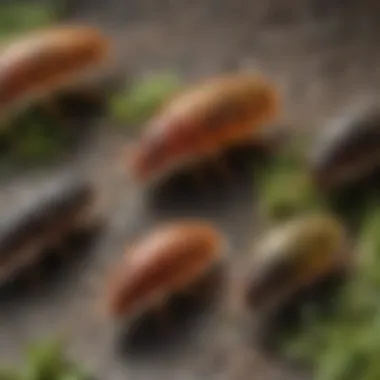
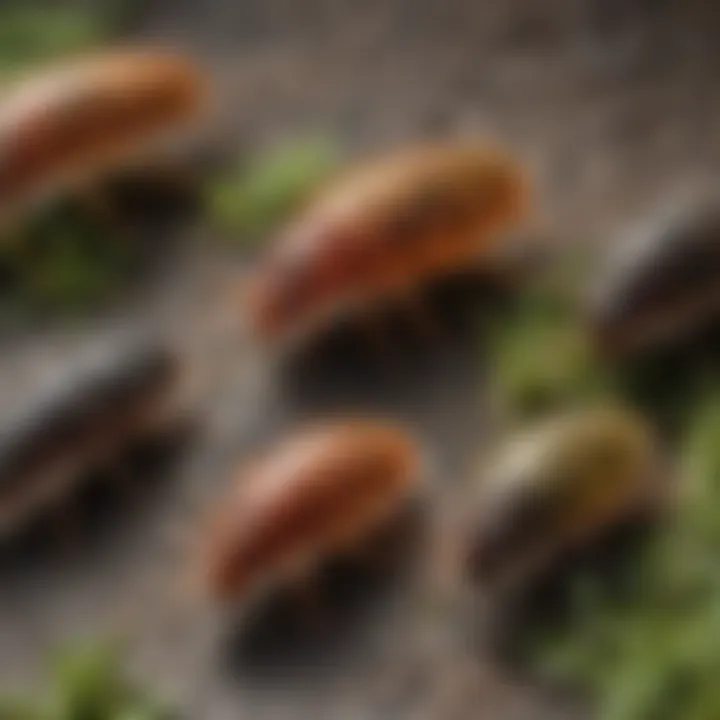
- Eggs: Female springtails can lay hundreds of eggs at once, typically within organic matter or moist soil.
- Juveniles: Upon hatching, juvenile springtails closely resemble adults but are smaller and lack fully developed reproductive organs.
- Adults: Springtails reach maturity within a few weeks and can live for months, continuously reproducing in favorable conditions.
Understanding their life cycle is vital for effective pest management. The juveniles along with adults can quickly multiply under optimal conditions, prompting the need for timely intervention to prevent infestations.
By gathering insight into these basics about springtail bugs, homeowners can arm themselves with the knowledge required for effective pest control strategies. Attention to their behaviors, habitat preferences, and life cycles paves the way toward sustainable management solutions.
Identifying a Springtail Infestation
Identifying an infestation of springtail bugs is crucial for effective management. Springtails are small, jumpy insects that can be difficult to spot. By recognizing the signs of their presence, homeowners can take prompt action to mitigate the problem. Early detection can prevent these pests from multiplying and causing further issues. Understanding what to look for, how they differ from other pests, and where they commonly reside in the home provides the foundation for a targeted response. This segment details these elements to facilitate easy and effective identification.
Signs of Infestation
The signs of a springtail infestation are often subtle yet noticeable. Homeowners may observe tiny, jumping insects, mainly in damp areas. Here are the key indicators to look for:
- Movement: Springtails are known for their agility. Spotting them jump swiftly when disturbed is a significant symptom of an infestation.
- Presence of small black or gray specks: These bugs are typically light brown or gray. They can sometimes be mistaken for dust or dirt, but a closer look may reveal their movement.
- Moist areas: High humidity zones, such as bathrooms or near leaky pipes, often attract springtails. If you notice them in such locations, that’s a strong indicator.
- Soil disturbance: When observing houseplants, consider inspecting the soil. Unusual movement or disturbances in the soil can point to springtails burrowing.
It is essential to remember that identification requires keen observation. The sooner one recognizes these signs, the sooner a plan of action can be implemented.
Distinguishing from Other Pests
Differentiating springtails from other household pests can be challenging but is vital. Other small insects may resemble them, including flea or whiteflies. Here are some aspects to help with this classification:
- Size and Color: Springtails are generally small, measuring between 1 to 2 mm. Their bodies are not only small but also soft. Treated fleas tend to be larger and their body structure is more rigid. Springtails vary in color, usually resembling gray or brown, unlike other pests which may have a more vivid color.
- Movement Style: Springtails jump when they feel threatened. This mode of movement is distinctive compared to ants or beetles that crawl.
- Features: Springtails possess a tail-like appendage that enables them to jump. This feature is absent in many similar-sized pests, making it easier to identify them.
Being attentive to these details can aid homeowners in identifying springtails more accurately and prompt an appropriate response.
Common Areas of Infestation
Springtails thrive in damp environments and can be found in various locations within a household. Recognizing these hotspots is essential for effective target control. Here are the most common areas where springtails often infest:
- Bathrooms: Humid air, leaking sinks, and showers provide an ideal habitat. Check under bathroom sinks and corners where moisture accumulates.
- Kitchens: Food residues and damp spots attract springtails. Pay attention to areas near dishwashers and refrigerators.
- Laundry Rooms: Wet cloths or unwashed laundry can create a perfect environment for these pests.
- Indoor Plants: They often thrive in the soil of potted plants, particularly in overwatered conditions. Observe the potting soil closely.
- Basements and Caves: These areas are usually damp and dark, offering a suitable habitat for springtails.
By knowing where to look, a homeowner can effectively assess their surroundings and act swiftly to control any potential infestations.
Factors Contributing to Infestations
Identifying the root causes behind springtail infestations is crucial for effective management. By understanding these factors, homeowners can take proactive measures to prevent these pests from taking hold. It is often said that prevention is better than cure, especially when it comes to infestations. In this section, we will explore three primary factors that contribute to springtail infestations: moisture levels, organic matter accumulation, and indoor plants with their associated soil. Each of these elements plays a significant role in creating an environment where springtails thrive.
Moisture Levels
Springtails are often found in moist environments. They require water to survive and reproduce. Elevated humidity levels provide an ideal habitat for these pests. Common areas where high moisture occurs include bathrooms, kitchens, basements, and around plumbing leaks. Additionally, overwatering indoor plants can create excess moisture in the soil, further attracting springtails.
To mitigate moisture levels, homeowners should regularly check for leaks and repair them promptly. Using dehumidifiers can help maintain lower humidity levels in damp areas of the home. Furthermore, ensuring proper ventilation in areas susceptible to moisture buildup, like bathrooms, is vital. Consistent monitoring of indoor humidity levels is a simple yet effective strategy to deter springtail infestations.
Organic Matter Accumulation
The presence of organic matter is another factor that contributes to springtail infestations. Springtails feed on decaying plant materials, fungi, and other organic debris. These pests thrive in environments rich in organic matter, making homes that accumulate excessive plant debris or have poorly maintained gardens more susceptible to infestations.
Homeowners can prevent this accumulation by regularly cleaning the yard and garden areas. Raking leaves, removing dead plants, and properly composting organic waste will reduce potential feeding grounds for springtails. Additionally, ensuring that food waste is stored in sealed containers can deter them from invading kitchens.
Indoor Plants and Soil
Indoor plants can be a double-edged sword in the context of springtails. On one hand, they can enhance the home’s aesthetic and improve air quality. On the other hand, if not properly cared for, they can foster springtail populations. Overwatering is a primary concern, as it leads to damp soil that attracts these pests. Furthermore, using contaminated soil can introduce springtails into your home.
To minimize risks, homeowners should:
- Choose well-draining pots and soil to prevent excess moisture.
- Water plants only when necessary, allowing the top layer of soil to dry out.
- Inspect new plants for pests before introducing them into the home.
By addressing these factors contributing to infestations, individuals can lay the groundwork for effective springtail management. Recognizing the importance of moisture levels, organic matter, and plant care plays a crucial role in the prevention of these pests.
Preventing Springtail Infestations
Preventing springtail infestations is crucial for maintaining a safe and healthy living environment. Springtails thrive in moist conditions, so control over humidity is essential. By implementing preventive measures, homeowners can significantly reduce the likelihood of an infestation. This not only protects the home but also minimizes the need for costly and labor-intensive treatments later on. Understanding the factors that attract springtails enables effective long-term pest management practices.
Moisture Control Strategies
One of the primary strategies for preventing springtail infestations involves controlling moisture levels in and around the home. Since springtails are attracted to damp environments, reducing excess moisture can deter their presence. Here are some effective methods to control moisture:
- Dehumidifiers: Using a dehumidifier can help maintain optimal humidity levels in basements and other high-moisture areas.
- Ventilation: Ensure proper ventilation in bathrooms and kitchens. Installing exhaust fans can help eliminate excess humidity.
- Leak Repair: Promptly address any leaks in plumbing or roofing. Water accumulation from these sources can create conducive conditions for springtails.
Regularly monitoring humidity levels can also prevent conditions that invite infestation. Keeping family and pets safe would be a key benefit.
Proper Waste Management
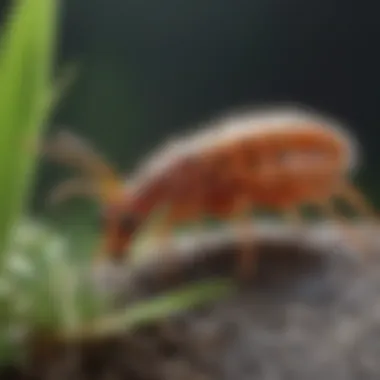
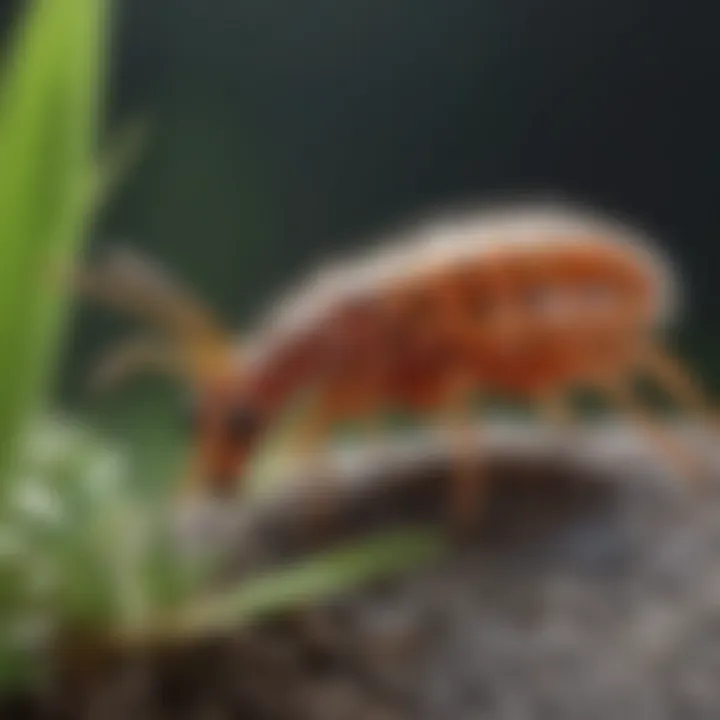
Effective waste management is another critical element to preventing springtail infestations. Accumulation of organic matter can be a breeding ground for pests. By following these waste management practices, you can keep your surroundings clean and less appealing to springtails:
- Regular Trash Disposal: Dispose of garbage frequently, especially organic waste, which can attract pests.
- Composting Caution: If you compost, ensure it is managed properly. Keep the compost dry and aerated.
- Garden Maintenance: Regularly clean up fallen leaves and organic debris in gardens and around the home. Overgrown vegetation can lead to increased moisture and pest populations.
Implementing these waste management strategies promotes a cleaner environment and significantly reduces the risk of infestation.
Indoor Plant Care
Indoor plants can be both a joy and a challenge, especially when it comes to pest management. Proper care of indoor plants is essential for preventing springtail infestations. Here are important considerations:
- Soil Health: Use sterilized soil when planting. Avoid using soil from outdoor sources that may contain springtails.
- Overwatering Practices: Be cautious not to overwater your plants. Allow soil in pots to dry out between watering to minimize damp conditions that attract springtails.
- Inspection: Regularly inspect plants for signs of pests or disease. If springtails are found in the soil, consider repotting with dry, clean soil.
By taking these steps with indoor plants, homeowners can enjoy greenery while keeping springtails at bay.
"Preventing springtail infestations centers around moisture control, waste management, and proper plant care. These are simple yet effective strategies that can protect your home from unwanted pests."
Implementing comprehensive preventive measures will result in a reduced risk of infestation, ensuring a more pleasant living environment.
Treatment Options for Springtail Bugs
Addressing an infestation of springtail bugs requires a strategic approach through effective treatment options. Understanding these methods is crucial, as each offers unique benefits and addresses different aspects of control. By employing a combination of natural and chemical solutions, homeowners can effectively combat springtails and reduce their population significantly. These treatment options also emphasize sustainability and safety, essential when considering the environment and household members. Identifying the right treatment method depends on the specific circumstances of an infestation, including its severity and the preferences of the homeowner.
Natural Treatment Methods
Natural treatment methods for springtails include a range of strategies that utilize non-chemical substances. These methods are particularly appealing to those who prefer eco-friendly solutions. One effective approach is the use of diatomaceous earth. This natural powder is made from fossilized algae and works by dehydrating the springtails upon contact. Simply sprinkle it in areas where springtails are present, and it will create a barrier that they cannot cross without harm.
Another method is the use of essential oils. Oils such as tea tree, eucalyptus, and peppermint have insecticidal properties. To apply this, mix a few drops with water in a spray bottle and mist it in areas where springtails are spotted. Regular use can help deter these pests while leaving a pleasant scent in the home.
In addition to these methods, maintaining a dry environment limits the habitats where springtails thrive. Proper ventilation, using dehumidifiers, and fixing plumbing leaks can significantly reduce moisture levels in your home, thereby making it less hospitable for springtails.
Chemical Solutions
When natural methods do not adequately handle a springtail infestation, chemical solutions may be necessary. These treatments, while sometimes more potent, require careful application and precautions. Insecticides specifically designed for springtails are available, often in spray or granular form. It is vital to follow the label instructions closely to ensure both efficacy and safety for household pets and children.
One recommended product is the Bifenthrin insecticide, known for its quick action against springtails. Applying it in areas where springtails are commonly found, such as basements and around the foundations, can help minimize their population. However, caution should always be exercised with chemicals, keeping in mind their potential impact on the local ecosystem.
Combining Treatment Options
A multifaceted approach is the most effective when dealing with springtail infestations. Combining natural methods with chemical solutions maximizes effectiveness while mitigating risks. For instance, homeowners can start with natural treatments to establish control, applying diatomaceous earth and essential oils initially. If the infestation persists, integrating a targeted chemical treatment can help cover the areas where springtails are still present.
It is also beneficial to continually monitor the situation and adjust your approach based on observed changes. By combining treatment options, you create a comprehensive strategy that not only deals with the immediate problem but also works to prevent future infestations.
Effective management of springtail infestations requires ongoing effort and adaptability. Combining various treatment methods will yield the best results and sustain a pest-free environment.
Biological Control Methods
Biological control methods provide a sustainable and effective way to manage springtail infestations. This strategy relies on the use of natural predators to keep springtail populations in check. By utilizing the principles of ecological balance, homeowners can reduce reliance on chemical treatments and promote a healthier environment.
Introducing Natural Predators
Natural predators, such as predatory mites, are effective allies against springtail populations. These small arachnids feed on springtails and can significantly reduce their numbers. Introducing predatory mites into indoor plants or affected areas can result in a visible decline of springtail activity.
Key considerations when using natural predators include:
- Right Species: Choose the correct species of predatory mite that targets springtails.
- Habitat Suitability: Ensure the environment is conducive for the predators to thrive. This includes moisture levels and availability of food sources.
- Sustainability: Natural predators can help maintain control over time, so their introduction aligns with long-term management strategies.
The introduction of these beneficial organisms is often simple and requires minimal intervention. Using commercially available predatory mites can bridge the gap between effective pest management and environmental stewardship.
Promoting Ecosystem Balance
Ecosystem balance is crucial for effective pest management. Maintaining a diverse ecosystem in and around your home can help control springtail populations naturally. A balanced ecosystem means that the natural predators of springtails can thrive alongside other beneficial insects and organisms.
To promote ecosystem balance, consider the following strategies:
- Diverse Planting: Incorporate a variety of plants in your indoor and outdoor spaces. Different plant species can attract different beneficial insects.
- Avoid Chemical Pesticides: Refraining from using broad-spectrum pesticides can protect beneficial species from being harmed.
- Regular Habitat Maintenance: Keeping spaces clean and removing excess organic matter can deter the conditions needed for springtails while supporting their natural predators.
"Promoting a balanced ecosystem not only aids in controlling pests but also benefits overall plant health and biodiversity."
By focusing on biological control methods, homeowners can create a more harmonious living environment. This approach not only targets springtail infestations effectively but also empowers individuals to practice environmentally friendly pest management.
Post-Treatment Management
Post-treatment management is essential to ensure the long-term effectiveness of your chosen methods for eliminating springtail bugs. After taking action against an infestation, whether through natural, chemical, or biological means, the measures you implement afterward will determine whether your efforts succeed or fail. It is important to consider both monitoring and prevention to keep your environment pest-free.
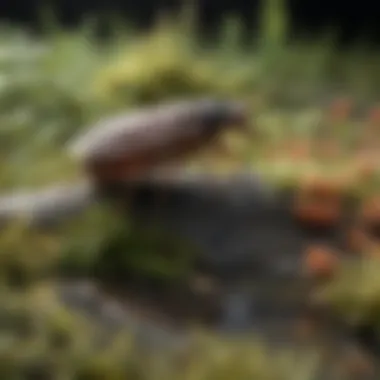

Monitoring for Reinfestation
Monitoring is a crucial step after treatment. This involves routinely checking the known hotspots where springtails were previously found. Inspecting the same areas every few weeks helps to identify any resurgence early on.
To effectively monitor, consider the following:
- Visual Inspection: Look for signs of springtails, such as small black specks and their characteristic jumping movement.
- Use of Sticky Traps: Setting up sticky traps around infested areas can help catch any lingering pests. Check these traps regularly for use and replace them as necessary.
- Humidity Monitoring: Since springtails thrive in moist environments, using a hygrometer to keep humidity levels in check can help prevent a return. Aim for indoor humidity below 50%.
Establish a routine that includes checking for reinfestation periodically. The earlier you detect springtails, the easier it may be to manage them before another extensive outbreak occurs.
Long-Term Prevention Strategies
Long-term prevention involves adopting practices that mitigate the factors that attract springtails. Here are some strategies to incorporate into your home management routine:
- Moisture Control: Keep areas of your home free from excess moisture. Adopt practices such as proper ventilation in bathrooms and kitchens. Fix leaks promptly and avoid overwatering houseplants.
- Decluttering: Eliminate piles of damp leaves or organic matter around your house and yard since these can serve as breeding grounds.
- Soil Management: If you own indoor plants, consider using sterile soil and ensure proper drainage. Avoid having old, decaying organic matter mixed into the potting soil.
- Routine Cleaning: Implement a regular cleaning schedule that includes vacuuming and dusting, particularly in areas where organic debris can accumulate. This reduces the organic matter that springtails thrive on.
By committing to these procedures, you will establish a robust line of defense against springtail reinfestations. A proactive approach will help protect your home over the long term.
"Effective post-treatment management is as critical as the treatment itself. Prevention and monitoring can save considerable time and resources down the line."
Overall, a strong post-treatment management plan is necessary for homeowners. It fosters a pest-free environment while ensuring that any previous efforts against pest populations do not go to waste.
When to Consult a Professional
Dealing with springtail bugs can be challenging for many homeowners. While there are numerous effective strategies for eliminating these pests, some situations may call for professional intervention. Recognizing when to seek help is vital for managing an infestation effectively. Professional pest control services offer specialized knowledge, experiences, and tools that surpass typical home remedies. This section will help you identify signs that indicate the need for professionals and guide you on choosing the right service.
Signs that Professional Help is Needed
Several indicators suggest it may be time to contact pest control experts. Here are some of the key signs to watch for:
- Persistent Infestation: If springtail bugs keep returning despite your efforts to eliminate them, this persistence can signal a more serious underlying problem that needs professional attention.
- Large Populations: When you notice an overwhelming number of springtails, DIY solutions may simply be insufficient. A large population often indicates a thriving environment, which is difficult to control without professional methods.
- Multiple Areas Infested: If the infestation is spreading beyond one area of your home or garden, it is a significant warning sign. Professionals can provide comprehensive mitigation strategies.
- Health Concerns: If someone in your household suffers from allergies or respiratory issues, a pest problem can exacerbate their condition. In such cases, it is best to act quickly.
- Unexplained Damage: If springtails are causing damage to your home or garden, it is advisable to consult experts who can provide tailored solutions.
By recognizing these signs early, you can prevent a minor issue from becoming a larger crisis.
Choosing a Pest Control Service
Selecting the right pest control service is crucial. It ensures that you get the most effective treatment for springtail bugs. Here are essential factors to consider:
- Experience and Expertise: Look for companies with a solid track record in dealing with springtail infestations. Check their qualifications and experience related specifically to pest management.
- Reputation: Research online reviews and testimonials to gauge the service’s effectiveness and customer satisfaction. Websites like Reddit and Facebook can provide insights from other homeowners.
- Methods Used: Inquire about the methods they use to treat springtail infestations. This includes whether they prefer chemical, biological, or integrated pest management approaches. Ensure their strategies are safe for your family and pets.
- Guarantees and Follow-ups: A reputable pest control service should offer guarantees on their work. Ask if they will revisit for follow-ups at no additional cost if the problem persists.
- Cost Estimates: Obtain and compare quotes from multiple services. Ensure you understand what is included in the pricing to avoid unexpected costs later.
Choosing a professional service may seem daunting, but careful consideration can lead to a successful resolution of your pest issue.
Myths and Misconceptions about Springtails
Understanding the myths and misconceptions surrounding springtail bugs is crucial for effective management. Many homeowners may form misinterpretations about these pests, often leading to ineffective treatment strategies or unnecessary panic. By addressing these misunderstandings, this article aims to provide clarity about what springtails are and how they can affect our living spaces.
Common Misunderstandings
One common misconception is that springtails are harmful to humans or pets. In reality, springtails are not known to bite or sting. They do not pose a direct threat to health. They primarily feed on decaying organic material and are often found in damp environments, such as soil or under leaf litter. While their presence may indicate underlying issues, such as excess moisture, their presence does not imply a threat.
Another misunderstanding is that springtails will cause substantial damage to household items. Unlike termites or carpenter ants, springtails do not eat wood or other solid materials. They may appear in large numbers but do not have a destructive impact on homes or belongings. These pests are more of a nuisance rather than a cause for severe concern.
Fact-Checking Infestation Myths
Many myths circulate about how to determine an infestation. One prevalent belief is that seeing one or two springtails means an infestation is present. This is misleading, as springtails can sometimes be spotted wandering into homes from outside environments without indicating a larger problem. It's essential to recognize that their population often fluctuates and may not necessarily indicate an infestation.
Furthermore, some homeowners think that spraying pesticides indiscriminately will solve a springtail problem. This approach can be counterproductive. Using harsh chemicals without addressing the root causes, such as moisture control, will not effectively eliminate springtail populations. Indeed, it may even harm beneficial insects, disrupting the natural ecosystem in the process.
"Belief in myths about pests can lead to incorrect treatments and unnecessary worry."
By focusing on factual information, homeowners can better respond to the presence of springtails, promoting a healthier living environment.
Ending
The conclusion of this article crystallizes the significance of understanding and managing springtail bug infestations. These pests, though often overlooked, can disrupt the comfort of any home. It is essential to appreciate the full cycle of infestation—from the signs of their presence to the steps for effective management. The insights provided here are not merely suggestions; they represent a framework for robust home pest control.
Summarizing Key Points
In this article, several crucial elements have been addressed:
- Understanding Springtail Bugs: Knowing their biology aids in recognizing potential issues early.
- Identifying Infestations: Recognizing signs and understanding where these pests typically reside is key.
- Preventive Measures: Implementing moisture control and waste management strategies can significantly reduce risks.
- Treatment Options: Both natural and chemical solutions have their places, dependent on the situation.
- Biological Methods: Encourage natural predators to maintain a balanced ecosystem in your surroundings.
- Post-Treatment Management: Continuous vigilance is necessary to prevent reinfestation.
- Professional Help: Knowing when to call in experts is crucial for severe infestations.
These points form a solid base for tackling springtails effectively.
Final Thoughts on Management
Managing springtail infestations requires a multifaceted approach. Regular monitoring and preventive maintenance should be habitual. Homeowners need knowledge, patience, and the right tools to effectively combat and prevent these pests. Consider the balance between ecological methods and traditional treatments, emphasizing health and safety for both people and pets. The ongoing commitment to these practices ensures a greater resilience against future infestations.
By adopting understanding and proactive management techniques, your home can remain a sanctuary free from the disruptions that springtail bugs can bring. Employ these strategies, and maintain an engaging relationship with your living space that prioritizes comfort and cleanliness.



